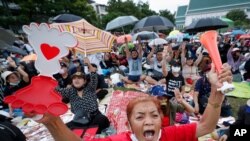Returning to Thammasat University 44 years after a massacre, Pojanee Theil describes Thailand as a country stuck in a loop.
Just a few hundred yards from the royal palace, the radical campus is once more the fulcrum of pro-democracy protests calling for sweeping reforms of Thai society and politics.
But as in the past, the military is refusing to let go of power, and the threat of a royalist establishment hangs heavy in the air.
“How could they have done this to other human beings?” laments 64-year-old Pojanee, a witness to the Oct. 6, 1976, events in which royalist mobs and security forces killed scores of students protesting at the return to Thailand of a hated general. “I’m right back where I was as a kid … and this country has gone nowhere since then.”
In 1976, left-wing protesters called for a new constitution and the ousting of Field Marshall Thanom Kittikachorn, a virulent anti-communist who had returned from exile.
This time, students at Thammasat have upped the ante.
They want a change of government, a new constitution and unprecedented reforms of the monarchy — an institution which has remained beyond public criticism, despite Thailand’s decades of political turmoil.
Outrage and sorrow were shared across generations on Tuesday’s anniversary, which marks one of the darkest days in Thailand’s bloody democracy struggle.
Among those gathering for a day of lectures and candle-lit memorials were many young people who have taught themselves about the bloody crackdowns, even though the suppressions were whitewashed from their school textbooks.
“The massacre should never have happened. It’s wrong,” said Punnapa, a 15-year-old high school pupil whose full name is withheld because of her age. She vowed to join the Thammasat law department when she is old enough.
“Only the law can bring change and justice,” she said.
New generation fights old battles
The latest protests have revived a fading democracy movement.
"What's special about this year's commemoration is that we see the ‘New Gen’ are very engaged in the political history of their country,” former student leader and political veteran Chaturon Chaisang told the crowd. “These dark memories are a driving force for their movement."
There have been no prosecutions for the shootings and lynchings of Oct. 6, many of which were captured in grisly TV footage showing piles of burning bodies and unarmed, half naked students forced to crawl on the campus football pitch under the boots of soldiers.
The bloodshed shaped the relationship between people and the state in modern Thailand, said Phil Robertson, deputy Asia director of Human Rights Watch.
“Ever since, the Thai people have struggled to break a cycle of violence and impunity,” Robertson said.
The Thai government and military have so far tolerated the latest protests. But calls for reform of the monarchy have moved the protesters onto dangerous ground in a land where the army chiefs swear loyalty to the palace.
Thailand became a constitutional monarchy in 1932, with a charter constraining palace powers drafted by coup leader Pridi Banomyong. He founded Thammasat University two years later, the campus becoming a cradle of radical thought for the generations since.
But democracy has never stuck in Thailand. Governments routinely fall to coups led by an arch-royalist army. Only one elected leader, Thaksin Shinawatra, has ever completed a full term. He served from 2001 to 2006.
Thaksin, a hero to the rural poor but reviled by the royalist elite, was booted from power by the army, setting in motion 14 years of short-lived governments, political violence, army takeovers and economic malaise.
The youth protesters want to force out the current government of Prayut Chan-o-Cha, an ex-army chief who took power in another 2014 coup.
History repeating itself?
Thammasat is again the reference point in a country unable to escape its past.
"Let it be known that our Oct. 6 heroes did not die in vain,” said Anon Nampa a radical lawyer and one of the strongest voices calling for palace reform, at Tuesday’s memorial. “We promise to keep fighting, pushing into taboo territory."
Super rich, protected by a lese-majeste law and the army, Thailand’s royal family has been off-limits to previous rounds of democracy protests. But Anon, and several other leaders of the creative youth-facing movement, have called for King Maha Vajiralongkorn to abide by the 1932 constitution.
He ascended the throne in 2016 and has since tightened his grip on the crown’s immense wealth and on special army units under his direct control.
The protest groups say they will unite on Oct. 14 in the heart of Bangkok for a peaceful mega-rally designed to test the breadth of public support for their movement.
To tip the government toward crisis, they will need a "mob" that is larger than the 30,000 or so who met in late September, Thai watchers say.
“I know that every time we organize a mob, flashbacks to traumatic memories come to mind,” said student and political activist Panusaya Sithijirawattanakul in front of the memorial to the Oct. 6 massacre.
“Will history repeat itself? We will do the best we can to protect everyone,” she said.




